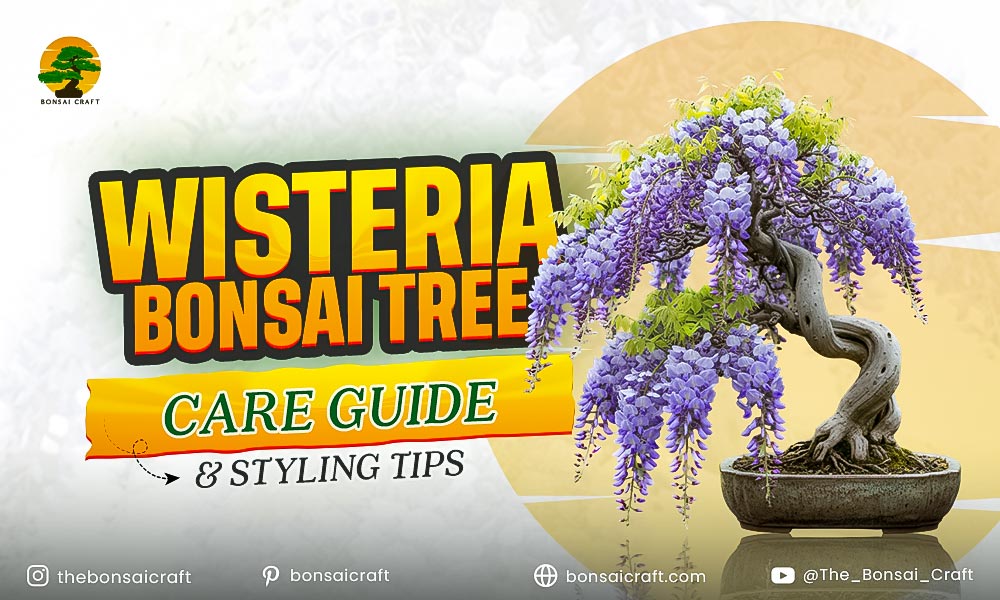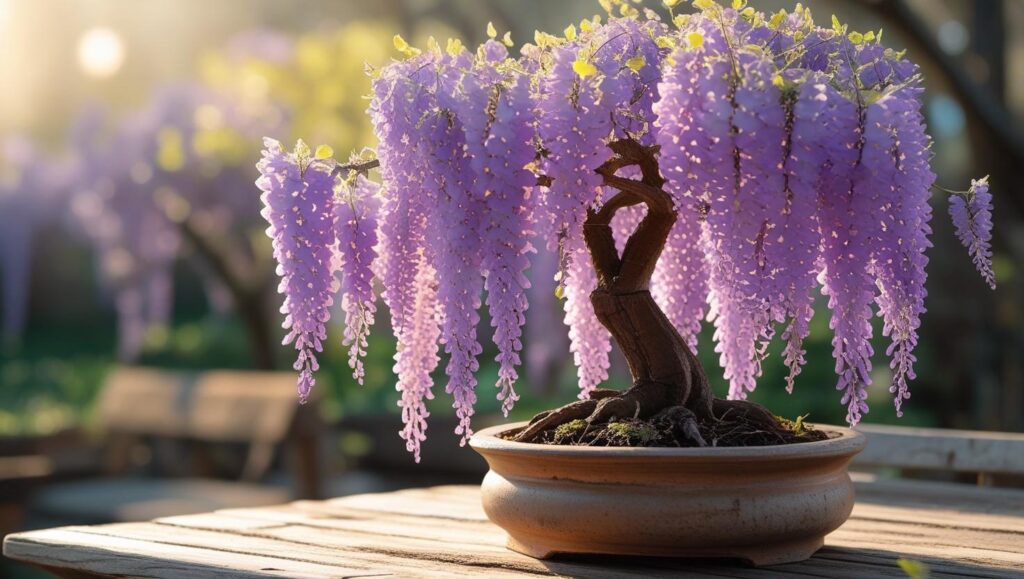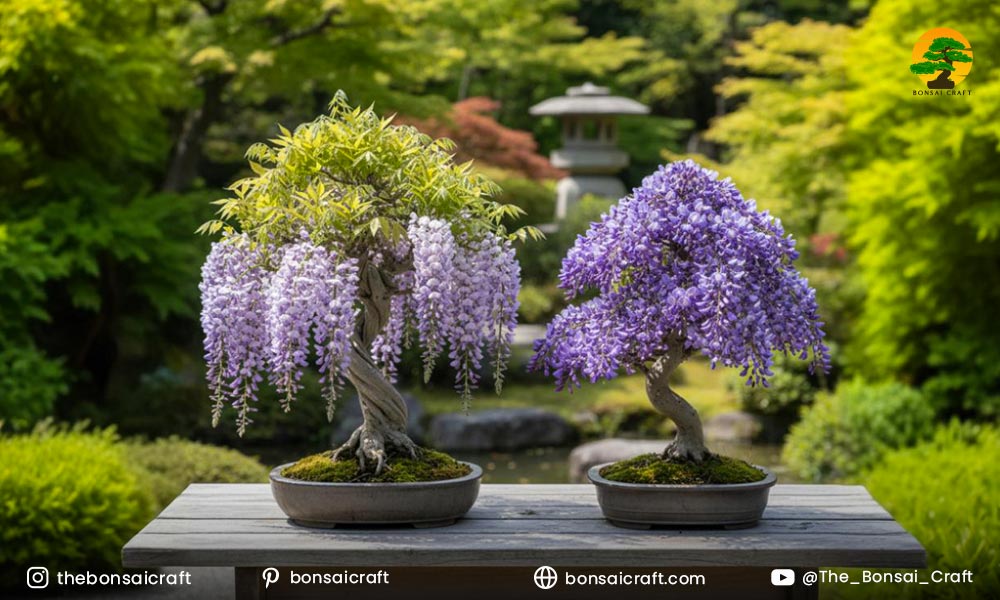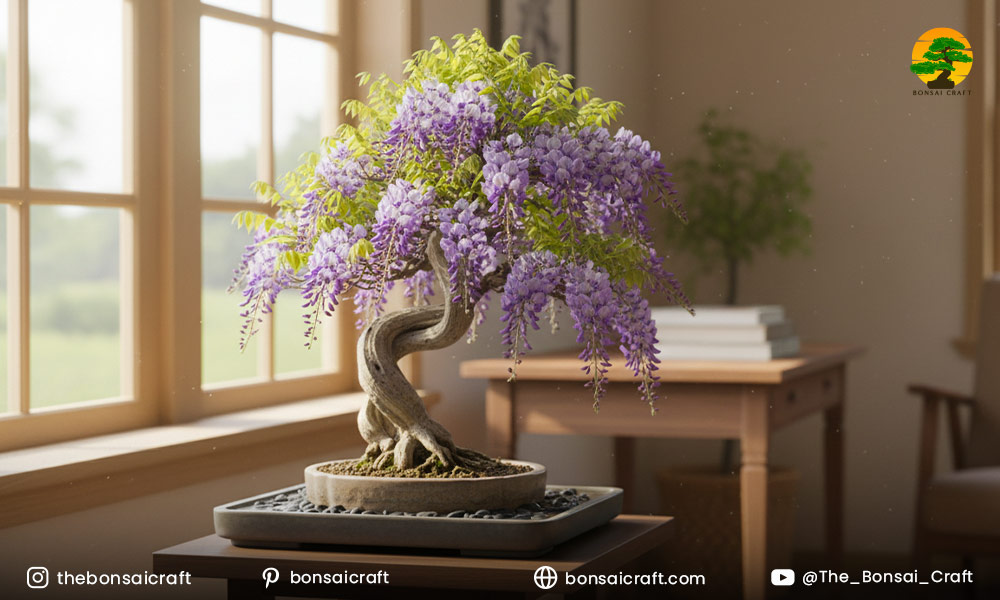
Wisteria bonsai are famous for their stunning and tranquil flowers that capture the eye with their beauty and their cascading blooms that smell pleasantly flawless. Growing a bonsai wisteria is a wonderful experience, although challenging, which will undoubtedly put your skills and patience to the test. This guide will walk you through all the pruning and training steps involved with growing a wisteria bonsai tree, including the selection of the proper species, so you have complete mastery of this wonderful plant.
What is a Wisteria Bonsai Tree?

A wisteria bonsai tree is a miniature version of the wisteria vine, known for its cascading flowers. Grown in a container, it mimics the beauty of full-sized wisteria while requiring careful pruning, watering, and sunlight to thrive.
A wisteria bonsai tree replicates the full-sized wisteria bonsai tree, with its cascading flowers in purple, blue, or white shades. It is a wisteria vine miniaturized into a bonsai, cultivated in a pot to resemble its full-size sibling. This kind of bonsai is rather difficult to grow, but once the effort is put into caring for it, the result is breathtaking. Caring for a bonsai wisteria involves meticulous attention to detail, especially with pruning, watering, sunlight, and the growing season. Proper care will allow it to bloom for many years, which will beautify indoor or outdoor spaces.
How to Care for Your Bonsai Wisteria: Essential Maintenance Tips
Care for bonsai wisteria by providing well-draining soil, watering when the topsoil is dry, and ensuring at least 6 hours of sunlight. Regular pruning, shaping with wire, and repotting every 2-3 years will keep it healthy and thriving.
Continuous care helps the wisteria bonsai achieve the care goals set. For the wisteria bonsai, provide soil with better drainage and water only when the topsoil feels dry. For healthy blooming, place the tree in a bright location with at least 6 hours of sunlight per day. Annual spring pruning is vital is maintain shape and blooming. Gradual wiring can create a cascading shape with the branches. Every 2-3 years, repotting is a must to prevent the tree from becoming root-bound. Applying balanced fertilizer will significantly enhance growth and flowering in the wisteria bonsai.

Chinese Wisteria Bonsai vs. Japanese Wisteria Bonsai: Key Differences
Chinese wisteria bonsai (Wisteria sinensis) grows vigorously with long, fragrant flowers, while Japanese wisteria bonsai (Wisteria floribunda) has shorter flower clusters in various colors. The key differences in the bonsai stems from the varieties of Wisteria sinensis and Wisteria Floribunda.
Chinese wisteria bonsai blooms with long and fragrant blossoms (Wisteria sinensis). In contrast, Japanese wisteria bonsai (Wisteria floribunda) has shorter and concentrated flowers. Wisteria Sinensis boasts longer and fragrant flowers. Chinese wisteria bonsai is known for vigorous growth. Japanese wisteria bonsai (Wisteria floribunda) produces slightly smaller flowers in a wider range of colors, from white to purple and blue. Both species need routine care like consistent watering and sunlight, sunlight, and watering. Generally, Chinese wisteria grows faster and is more demanding. Japanese wisteria has shorter growth periods and is more adaptable to different climates.
Best Conditions for Growing Wisteria Bonsai Trees
Wisteria bonsai trees thrive in well-draining soil, moderate humidity, and a location with at least 6 hours of direct sunlight. They require regular pruning, watering only when the soil is dry, and occasional fertilization during the growing season.
To survive, wisteria bonsai trees are sensitive to temperature and humidity. For potting, use shallow and wide containers. The soil should contain a mixture of akadama, pumice and lava rock. These trees will thrive in six hours of direct sunlight a day, provided the bonsai is placed in a well-lit area. As for humidity, keep it at a moderate level and follow the watering guideline of the plant only when the top soil is dry to the touch. Shape the wisteria bonsai and encourage blooms with pruning. For robust growth during the growing season, apply balanced fertilizers.
In terms of repotting the wisteria trees, they should be repotted every two to three years. This will assist with issues related to the wisteria trees being root-bound. Repot every 2-3 years to prevent root-bound issues.
How to Make a Wisteria Bonsai: A Step-by-Step Guide
To make a wisteria bonsai, start with a cutting or young plant. Select a shallow pot with well-draining soil, prune roots regularly, and shape branches using wire. Ensure the plant receives adequate sunlight and water, and prune regularly for the desired shape.
Step one is to get a Wisteria cutting or a young plant. Then take a wide shallow pot and fill it with a mixture of akadama, pumice, and lava rock. This mixture will ensure good drainage. Shape cascading branches with gentle wiring and remember to remove the wires and reshape the branches after 1-2 months. Cut the following branches and thin the outer leaves for a rounded dome shape. Wisteria needs full sun for them to bloom and a spot with at least 6 hours of sunlight is ideal. Water after the topsoil is dry, but remember to remove excess water. A good pruning will enable a defined outer shape and will promote better blooming in the following seasons.
The Bonsai roots need to be pruned every two to three years to maintain the size. The branches also need to be shaped through gentle wiring. Wisteria likes the sun for at least six hours a day, making a constant temperature ideal. Balancing the pruning will allow the shape of the tree to be defined better after every season. Trimming the outer shape of the leafy tree will keep the dense shrub effect and will be best for the following years of bloom.
Wisteria Sinensis Bonsai: A Popular Choice for Beginners
Wisteria sinensis bonsai (Chinese wisteria) is ideal for beginners due to its fast growth, long flowering clusters, and ease of care. With proper pruning and sunlight, this species can thrive in bonsai form and produce stunning blooms in just a few years.
As a wisteria species, it is an excellent choice for bonsai beginners owing to its robust growth and long flower clusters. Chinese wisteria bonsai are moderately easy to care for; they require direct sunlight for a minimum of six hours a day, well-draining soil, and a few pruning sessions to shape the plant. Chinese wisteria bonsai flourish when the roots have ample space and can bloom within three to five years. On the whole, the species is forgiving and easy to shape, as long as the roots are pruned and maintained.
How to Integrate Wisteria into Your Bonsai Collection
Integrating wisteria into your bonsai collection involves selecting the right pot, providing ample sunlight, and regular pruning. Pair it with other species that complement its cascading growth and add visual harmony to your collection.
A wisteria bonsai adds stunning visual and olfactory delights to your collection. Other miniature trees, such as Ficus or Junipers will complement wisteria’s cascading growth beautifully. To integrate it properly, your wisteria bonsai should be grown in a shallow, wide bonsai pot filled with free-draining soil. It should be placed where it can receive 6 hours of direct sunlight. It is important to prune and shape the plant with some wiring to allow for its structural maintenance and blooming encouragement. To highlight wisteria’s beauty, consider pairing it with compact flowering bonsai or flowering conifers making the collection balanced and blended.
Growing Wisteria Bonsai Indoors: Tips for Success
To grow wisteria bonsai indoors, provide a sunny spot with at least 6 hours of sunlight daily. Ensure good airflow, moderate humidity, and well-draining soil. Regular pruning and repotting every 2-3 years will help maintain its health and encourage blooming.
Growing wisteria bonsai indoors requires a bit of extra attention to ensure it thrives. Place it in a bright, sunny spot that gets at least 6 hours of direct sunlight daily. If natural light is insufficient, consider using grow lights. Wisteria bonsai also needs moderate humidity, so consider using a humidity tray or misting the leaves occasionally. Regular watering is essential, but be sure not to overwater, as wisteria is prone to root rot. Prune the bonsai regularly to maintain its shape and encourage blooming. Repot the tree every 2-3 years to prevent root binding, and make sure it’s in a draft-free area to avoid stress.
Can Wisteria Bonsai Survive Cold Climates?
Wisteria bonsai trees, especially Chinese wisteria, can survive cold climates if given a period of dormancy in winter. However, they should be protected from freezing temperatures and heavy frost to prevent damage.
Wisteria bonsai is quite tough and survives in cold regions. For example, Chinese wisteria (Wisteria sinensis) does well in cold areas. These bonsai require a dormancy period in winter, but they must be kept above freezing and protected from heavy frost as this can damage the bonsai. If grown outdoors in colder regions, wisteria bonsai should be sheltered during the coldest winter months. This can be done by bringing the bonsai indoors or covering it outdoors with a frost cloth. During the winter, wisteria bonsai in milder climates only require protection from cold snaps and can be kept outdoors year-round.
Wisteria Bonsai Tree Care Tips for Optimal Growth
For optimal wisteria bonsai growth, provide well-draining soil, prune regularly, ensure 6 hours of sunlight, and water only when the soil is dry. Fertilize during the growing season to promote healthy foliage and blooms.
For a wisteria bonsai, you must start the care tips with a well-draining soil mix of akadama, pumice, and lava rock. Siting the bonsai in a place with 6 hours of sunlight will ensure vibrant blooms and a healthy plant. Watering should only occur when the top layer of soil feels dry to the touch, while ensuring watering never leads to overwatering. Cutting bonsai in early spring is a must in order to shape the bonsai for stronger growth. Fertilizers with a balanced UE NPK ratio should be used to feed the wisteria bonsai during the growing season to improve the foliage and blooming flowers. The bonsai must be repotted every 2-3 years for the roots to remain healthy.
Maintaining Wisteria Bonsai: Common Challenges and Solutions
Wisteria bonsai maintenance challenges include excessive vine growth, a lack of blooms, and pest infestations. Regular pruning, adequate sunlight, and pest control can address these issues and help your bonsai thrive. Like other types of bonsai, wisteria bonsai poses its challenges.
Some of the common issues are vine overgrowth, lack of flowering, and pests like aphids and spider mites. To take care of vine overgrowth, make sure to prune during the active growth phase. To help your wisteria bloom, ensure it receives at least 6 hours of sunlight a day. For non-blooming wisteria, pruned trees, check your sunlight and fertilization levels, and adjust your pruning. Pests are easily managed with organic insecticides or neem oil. Pests such as aphids and spider mites can be managed if you regularly check your bonsai and eliminate problems at the initial stages to ensure the pests do not harm your bonsai.
What Soil and Watering Does Wisteria Bonsai Need?
Wisteria bonsai needs well-draining soil, such as akadama, pumice, and lava rock. Water only when the topsoil is dry to prevent root rot, and ensure the pot has good drainage.
Wisteria bonsai will flourish with a soil blend consisting of akadama, pumice, and lava rock. The akadama will retain some water, which is important, while pumice and lava rock ensure excess water drains freely. Wisteria are susceptible to root rot. To avoid this, water only when the top layer of soil is dry, and do not overwater. Good drainage holes in the pot are a must to prevent water retention. The bonsai should not be sitting in water, and any excess water in the saucer should be removed.
How to Prune and Shape Wisteria Bonsai?
Prune wisteria bonsai during early spring, removing unwanted branches. Shape the tree using wire to create a cascading effect. Regular root pruning every 2-3 years ensures healthy growth.
Pruning and shaping are both essential for beautiful wisteria bonsai. In early spring, before growth starts, begin pruning. Remove dead branches and shape the tree. Focus on disruptive and overly dense branches. Gently shape the tree with bonsai wire promoting a cascading design. Be careful to avoid tight wiring that will damage the branches. To prevent root binding and to maintain healthy growth, root pruning is necessary every 2 to 3 years when repotting. This helps maintain a compact wisteria bonsai form and promotes strong vibrant blooming.
How Often Should You Fertilize Wisteria Bonsai?
Fertilize your wisteria bonsai once a month during the growing season with a balanced, slow-release fertilizer. Use a high-potassium fertilizer to encourage flowering during spring and summer.
Fertilizing your wisteria bonsai is essential to promote healthy growth and flowering. During the growing season (spring to early summer), fertilize once a month with a balanced, slow-release fertilizer. Use a fertilizer with higher potassium content to encourage vibrant blooms. In the fall and winter months, reduce fertilization or stop altogether, as the tree enters its dormancy phase. Be sure to dilute the fertilizer according to the manufacturer’s recommendations, as over-fertilizing can lead to excessive leaf growth at the expense of flowers. Proper fertilization supports strong root development and ensures beautiful blooms for the next season.
Repotting Your Wisteria Bonsai: When and How?
Repot wisteria bonsai every 2-3 years, trimming the roots to prevent binding. Use fresh, well-draining soil and a slightly larger pot to allow for healthy growth. Repotting your wisteria bonsai every 2-3 years is essential to prevent root binding and promote healthy growth.
When repotting, gently remove the tree from its pot, trimming any overly long or congested roots. Make sure to refresh the soil with a mix of akadama, pumice, and lava rock to provide proper drainage and root aeration. Choose a slightly larger pot if needed to give the roots space to grow. Be careful not to damage the roots while repotting, and always water the tree thoroughly after replanting. Repotting helps rejuvenate the tree and encourages better flowering.

Common Pests and How to Protect Your Wisteria Bonsai
Wisteria bonsai can attract pests like aphids and spider mites. Regularly inspect for infestations and treat with organic insecticides or neem oil to protect your bonsai from damage.
Wisteria bonsai is susceptible to pests like aphids, spider mites, and scale insects. Regularly inspect your tree for signs of pest infestation, such as discolored or curled leaves. If pests are detected, treat the bonsai with organic insecticides or neem oil to eliminate the infestation. Be sure to apply the treatment according to the manufacturer’s instructions to avoid damaging the plant. Keeping your wisteria bonsai in a well-ventilated area and maintaining good hygiene will help deter pests. Additionally, maintaining proper watering and humidity levels can reduce pest attraction, ensuring your bonsai remains healthy and vibrant.
Conclusion
Wisteria is not only one of the most stunning bonsai but also one of the most rewarding to care for. The beauty it brings can be appreciated when strategically placed in your home, with elaborate care required to shape and cultivate it, making the effort well worth it. With the right selection, care, and critical pruning techniques, wisteria flowers can be enjoyed in delicate, compact, and easy-to-manage forms.
If taking on the challenge sounds appealing, begin with selecting the right wisteria species for you, and ensure patience is exercised throughout the entire growth process. Whether you are new to the bonsai world or have been an experienced enthusiast for a while, bonsai wisteria will provide you with years of joy and a connection to nature as it grows.
FAQ
How Long Does It Take for a Wisteria Bonsai to Bloom?
A wisteria bonsai will normally bloom in 3 to 5 years. However, this time frame varies depending on the species, care, and environment. Proper care and patience tend to be the primary factors in ensuring successful flowering.
Can Wisteria Bonsai Be Grown Indoors?
Yes, wisteria bonsai can be grown Indoors, although they will need to be positioned in a location that receives ample natural sunlight. Put them in a well-lit area with 6 or more hours of direct sunlight, proper humidity, and adequate watering.
How to Make Your Wisteria Bonsai Flower?
To make wisteria bonsai bloom, sunlight for 6 hours or more must be provided. Regular pruning along with high-potassium fertilizer also helps. Be careful not to over-prune or else the flower buds may be lost.
Why is My Wisteria Bonsai Not Flowering?
Wisteria bonsai may not bloom due to improper fertilization, inadequate pruning, or even a lack of sunlight. Make sure to encourage your tree to gain more sunlight and prune it adequately to promote flowering.
When should I prune my bonsai wisteria?
In preparation for the growth cycle, prune your bonsai wisteria in early spring. Start by removing any unwanted or dead branches, and then shape the tree by trimming back long growth.


